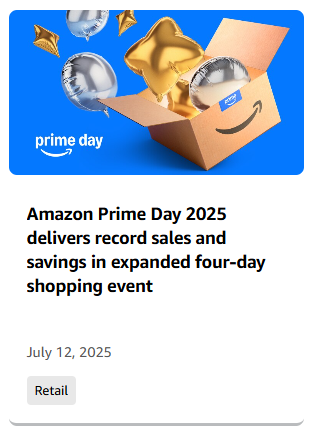July 15, 2025
Prime Day 2025 Recap
Key Takeaways for Brands and Advertisers
Amazon’s Prime Day 2025 has officially wrapped — and it was bigger, longer, and more complex than ever before. For brands and advertisers navigating the event, evaluating its success isn’t as simple as looking at top-line sales numbers.
This year’s event expanded from the traditional two-day format to a four-day marathon, running from July 8–11. While this move helped drive record-breaking sales, it also introduced new challenges and shifts in shopper behavior. Let’s break it down.
Prime Day 2025 by the Numbers
By the metrics alone, Prime Day 2025 was a resounding success:
-
U.S. online spend reached $24.1 billion, a 30% increase year-over-year, according to Adobe Analytics.
-
Amazon reported that this was its “biggest Prime Day ever,” with more items sold than any previous year and customers saving billions across 35+ categories.

-
Top-selling items included Apple AirPods Pro (2nd Gen), Amazon devices like the Fire TV Stick and Ring Battery Doorbell, and household essentials such as Premier Protein Shakes and Dawn Platinum Powerwash.
Third-party sellers also had record-breaking performances, with small and independent brands seeing all-time highs in both revenue and items sold.
Shifting Consumer Sentiment
While sales soared, consumer sentiment was mixed. Many shoppers felt the deals weren’t as deep or as exclusive as advertised. Across Reddit, X (formerly Twitter), and even in major news outlets, shoppers highlighted so-called “fake deals,” noting that some discounts were no better than pre-event pricing.
However, plenty of Prime members still found value, especially on everyday essentials and Amazon-branded products. Influencer-driven content played a major role, with creators across TikTok, YouTube, and Instagram helping drive nearly 20% of U.S. online sales during the event.
Our Advertising Performance Analysis
At Ad Advance, we took a close look at Sponsored Ads performance to understand how this year’s expanded event stacked up. Rather than relying on a simple year-over-year comparison — which wouldn’t account for changes in client mix and overall growth — we focused on each event’s lift against its respective five-week trailing average.
Prime Day 2024 average lift (two days):
-
Impressions: +179%
-
Sales: +147%
Prime Day 2025 average lift (four days):
-
Impressions: +65%
-
Sales: +62%
When summing the total event impact, Prime Day 2024 still led:
Prime Day 2024 total event lift:
-
Impressions: +357%
-
Sales: +293%
Prime Day 2025 total event lift:
-
Impressions: +261%
-
Sales: +249%

The shift to four days gave shoppers more time to browse, compare, and wait for the best possible deals — which spread out ad performance more evenly and reduced the “surge” effect we typically see during a tighter two-day window.
Outside Factors at Play
Several external factors also shaped this year’s event:
-
Economic headwinds: Lower overall consumer confidence and inflation concerns made shoppers more cautious.
-
Tariffs and pricing dynamics: Global supply chain costs impacted margins and influenced discount strategies.
-
Increased competition: Retailers like Walmart, Target, and Best Buy ran competing sales events, further fragmenting shopper attention.
Despite these challenges, many of our clients achieved their best single sales days ever, showing that Prime Day can still deliver major wins when approached strategically.
The New Shape of Prime Day Success
Prime Day 2025 showed us that success might not always look like massive short-term spikes. Instead, brands saw sustained traffic and conversions spread over a longer period, with more strategic purchasing behavior from shoppers.
For advertisers, this means leaning into strategies that emphasize ongoing relevance and readiness to capture demand at every stage of the event — not just chasing a two-day surge.
Key Takeaways for Advertisers for Future Prime Days
-
Prepare for a marathon, not a sprint. With an extended event, pacing budgets and bids becomes even more critical.
-
Focus on essentials and replenishable products. Many top sellers were everyday items, signaling opportunities beyond big-ticket tech.
-
Leverage influencers and social proof. Shoppers are increasingly discovering deals through creator content, not just ads.
-
Plan for external competition. Expect competing sales from other major retailers to continue overlapping with Prime Day, diluting attention.